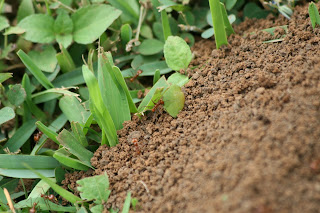The Leaf Cutter Ants.
Leaf cutter ants. The Superbugs!
Ants form a single family, the Formicidae, in the insect order Hymenoptera (ants, bees, and wasps). 84 genera of ants are known from Costa Rica. Genera are distributed in 14 subfamilies.
The leaf cutter ants get their name from the way they cut leaves from trees. They are considered one of the most complex and organized animal societies on Earth! Their colonies are definately a model of efficiency.
The leaf cutter colony is divided into castes, and each of them perform different functions:
1-MINIMS: (nursers)These are the smallest workers and they take care of the growing brood or care for the fungus gardens and are responsible for feeding the colony. They will also ride on top of the workers to protect them from any attack of the parasitic phorid flies that could lay its eggs on the ant´s head and cause its death.
2-MINORS: They are a little larger and represent the first line of defense .Their job is to patrol the surroundings and attack any enemies that could mean a threat for the colony.
3-MEDIAE: (workers)These are the ants that cut leaves and bring them to the nest.
4-MAJORS: (soldiers)They are the largest ants and act as soldiers that defend the nest from intruders. Also they clear the foraging trails.
Leaf cutter ants travel far into the forest, in search of leaves. they leave a scent (pheromones) along the trail so they can find their way back home. They use their mandibles to cut leaves from plants, and then carry the large pieces of leaves over their back. A leaf cutter ant can carry 9 times its own weight!
This ants build huge nests, that could reach more than 100 ft across, some nests descending 6 meters deep. In one colony there can be two to five million ants.
The leaf cutter ants don't eat the leaves, instead they use it as compost to grow a type of fungus, which they eat and feed to their young. They use a wide variety of trees and plants to provide the leaves. Leaves from one tree are only taken to part of the nest. This prevents a widespread disaster if the leaves are infected. New material is continuously incorporated into the gardens and old material is removed and placed in refuse dumps away from the colony. Leaves are licked clean of all spores that may interfere with the growth of the harvest fungus.
This resource of food is so precious for the survival of the colony that the ants use antibiotics (Actinobacteria ) from strains of bacteria to kill alien fungi (Escovopsis) that could invade and devastate their gardens. In the nest, these antibiotics are produced by actinomycete bacteria that live on the ants in a mutual symbiosis.
Scientists believe that the ants feed the bacteria through glands.
Actinobacteria is a Gram positive bacteria typically found in the soil. Many antibiotics have been discovered in these microorganisms which are responsible for producing about 80% of the world´s antibiotics.
The is an important relation between the ants and the fungi called mutualism. The ants get food from the fungus because if it is lost, the entire colony may die. In return, the fungus receives a continuous supply of growing material, and protection from the environment and from disease.
The Queen's job is to lay eggs and found new colonies. When a new future queen wants to establish its own new colony she has wings. She takes a piece of fungal material from a garden and puts it into a special pocket in her head to start her new fungus garden. Then, she flies away in search of a male. After she mates, she looks for a suitable spot for a colony and digs her nest. Soon, she starts laying hundreds of eggs every day. The male will die afterwards.
Fertilized eggs produce female ants (queens, workers, or soldiers); unfertilized eggs produce male ants. Workers and soldiers are sterile. Occasionally, the queen lays a few eggs that hatch into a female that can become another queen.
Termites belong to a completely different order, however, they are similar in many ways. Only 3 species in the world practice agriculture: ants, bark beetles, termites. Ant , bees, and wasps are related.



No comments:
Post a Comment